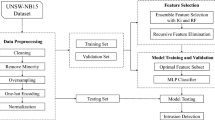Abstract
Feature selection can directly ascertain causes of faults by selecting useful features for fault diagnosis, which can simplify the procedures of fault diagnosis. As an efficient feature selection method, the linear kernel support vector machine recursive feature elimination (SVM-RFE) has been successfully applied to fault diagnosis. However, fault diagnosis is not a linear issue. Thus, this paper introduces the Gaussian kernel SVM-RFE to extract nonlinear features for fault diagnosis. The key issue is the selection of the kernel parameter for the Gaussian kernel SVM-RFE. We introduce three classical and simple kernel parameter selection methods and compare them in experiments. The proposed fault diagnosis framework combines the Gaussian kernel SVM-RFE and the SVM classifier, which can improve the performance of fault diagnosis. Experimental results on the Tennessee Eastman process indicate that the proposed framework for fault diagnosis is an advanced technique.





















Similar content being viewed by others
References
Aha DW, Kibler D, Albert MK (1991) Instance-based learning algorithms. Mach Learn 6(1):37–66
Chiang LH, Russell EL, Braatz RD (2000) Fault diagnosis in chemical processes using fisher discriminant analysis, discriminant partial least squares, and principal component analysis. Chemometr Intell Lab Syst 50 (2):243–252
Cho JH, Lee JM, Choi SW, Lee D, Lee IB (2005) Fault identification for process monitoring using kernel principal component analysis. Chem Eng Sci 60(1):279–288
Downs JJ, Vogel EF (1993) A plant-wide industrial process control problem. Comput Chem Eng 17 (3):245–255
Duda RO, Hart PE (1973) Pattern recognition and scene analysis. Wiley, New York
Guyon I, Weston J, Barnhill S, Vapnik V (2002) Gene selection for cancer classification using support vector machines. Mach Learn 46(1):389–422
Hotelling H (1947) Multivariate quality control. Techn Stat Anal 31(3):17–20
Hsu CC, Chen MC, Chen LS (2010) Intelligent ICA-SVM fault detection fault detector for non-gaussian multivariate process monitoring. Expert Syst Appl 37(4):3264–3273
Jackson JE (1959) Quality control methods for several related variables. Technometrics 1(4):359–377
Jiang QC, Yan XF, Huang B (2015) Performance-driven distributed PCA process monitoring based on fault-relevant variable selection and bayesian inference. IEEE Trans Ind Electron 63(1):377–386
Kleer JD, Kurien J (2004) Fundamentals of model-based diagnosis. In: 5th IFAC symposium on fault detection, supervision, and safety of technical processes(safeprocess)
Kramer MA, Palowitch BL (1987) A rule-based approach to fault diagnosis using the signed directed graph. Aiche J 33(7):1067–1078
Lee JM, Yoo CK, Lee IB (2004) Statistical process monitoring with independent components analysis. J Process Control 14(5):467–485
Mahadevan S, Shah SL (2009) Fault detection and diagnosis in process data using one-class support vector machines. J Process Control 19(10):1627–1639
Mao Y, Zhou XB, Pi DY, Sun YX, Wong STC (2005) Parameters selection in gene selection using gaussian kernel support vector machines by genetic algorithm. J Zhejiang Univ (Sci) 6(10):961–73
Mao Y, Zhou XB, Yin Z, Pi DY, Sun YX, Wong STC (2006) Gene selection using gaussian kernel support vector machine based recursive feature elimination with adaptive kernel width strategy. In: Proceedings of first international conference on rough sets and knowledge technology, lecture notes in computer science, vol 4062, pp 799–806
Mesleh AMA (2007) Chi square feature extraction based SVMs arabic language text categorization system. J Comput Sci 3(6):430–435
Pearson K (1900) On lines and planes of closest fit to points in space. Philos Mag Ser B 2(11):559–572
Qin SJ (2012) Survey on data-driven industrial process monitoring and diagnosis. Annu Rev Control 36 (2):220–234
Rubio G, Pomares H, Rojas I, Herrera LJ (2011) A heuristic method for parameter selection in LS-SVM: application to time series prediction. Int J Forecast 27(3):725–739
Shieh MD, Yang CC (2008) Multiclass SVM-RFE for product form feature selection. Expert Syst Appl 35 (1-2):531–541
Vapnik VN (1995) The natural of statistical learning theory. Springer, New York
Vapnik VN (2010) Statistical learning theory. Enc Sci Learn 41(4):3185–3185
Venkatasubramanian V, Rengaswamy R, Yin K, Kavuri SN (2003) A review of process fault detection and diagnosis: part III: process history based methods. Comput Chem Eng 27(3):327–346
Venkatasubramanian V, Rengaswamy R, Yin K, Kavuri SN (2003) A review of process fault detection and diagnosis: part I: quantitative model-based methods. Comput Chem Eng 27(3):293–311
Wang H, Song ZH, Wang H (2002) Statistical process monitoring using improved PCA with optimized sensor location. J Process Control 12(6):735–744
Wu J, Wang J, Liu L (2007) Feature extraction via KPCA for classification of gait patterns. Hum Mov Sci 26(3):393–411
Wu YC, Lee Y, Yang JC (2008) Robust and efficient multiclass SVM models for phrase pattern recognition. Pattern Recogn 41(9):2874–2889
Xu Y, Zhang D, Song F, Yang JY, Jing Z, Li M (2007) A method for speeding up feature extraction based on KPCA. Neurocopmuting 70(4-6):1056–1061
Xu ZB, Dai MW, Meng SY (2009) Fast and efficient strateqies for model selection of gaussian support vector machine. IEEE Trans Syst Man Cybern B Cybern 39(5):1292–1307
Yin S, Ding S, Haghani A, Hao H, Zhang P (2012) A comparison study of basis data-driven fault diagnosis and process monitoring methods on the benchmark tennessee eastman process. J Process Control 22:1567–1581
Zhang K, Qian K, Chai Y, Liu J (2014) Research on fault diagnosis of tennessee eastman process based on KPCA and SVM. In: 2014 Seventh international symposium on computational intelligence and design, vol 1, pp 490–495
Zhang L, Zhou WD, Li FZ (2012) Kernel sparse representation-based classifier ensemble for face recognition. IEEE Trans Signal Process 60(4):1684–1695
Zhou H, Hastie T (2005) Regularization and variable selection via elastic net. J R Stat Soc Ser B 67 (2):301–320
Acknowledgements
This work was supported in part by the National Natural Science Foundation of China under Grant Nos. 61373093, by the Natural Science Foundation of Jiangsu Province of China under Grant No. BK20140008, by the Soochow Scholar Project, by the Six Talent Peak Project of Jiangsu Province of China, and by the Collaborative Innovation Center of Novel Software Technology and Industrialization.
Author information
Authors and Affiliations
Corresponding author
Rights and permissions
About this article
Cite this article
Xue, Y., Zhang, L., Wang, B. et al. Nonlinear feature selection using Gaussian kernel SVM-RFE for fault diagnosis. Appl Intell 48, 3306–3331 (2018). https://doi.org/10.1007/s10489-018-1140-3
Published:
Issue Date:
DOI: https://doi.org/10.1007/s10489-018-1140-3




